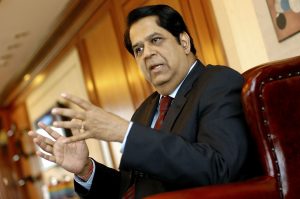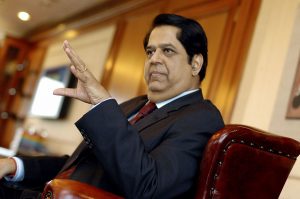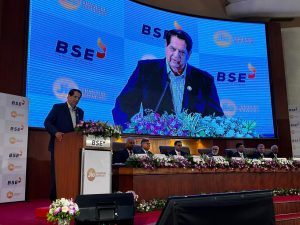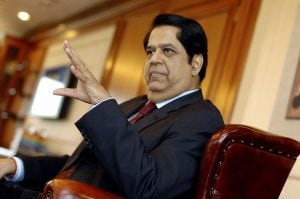Unforeseen data trends fuel optimism for India’s digital future | NaBFID Chairman KV Kamath

KV Prasad Jun 13, 2022, 06:35 AM IST (Published)
 Listen to the Article (6 Minutes)
Listen to the Article (6 Minutes)
Summary
Expressing optimism, KV Kamath, the Chairman of the National Bank for Financing Infrastructure and Development (NaBFID), mentioned that he focuses on two specific data points that are quite challenging for him to fully comprehend.
KV Kamath, the man at the helm of the National Bank for Financing Infrastructure and Development (NaBFID), in a conversation with CNBCTV-18 highlighted two intriguing data points that have proven to be delightful puzzles. Kamath delved into the realm of data consumption trends spanning the past half-decade. With a reflective nod to the bygone era, he said he could not have envisioned India’s rise as the global data consumption champion, while maintaining the most affordable pricing.
The second aspect is related to digital transactions, and Kamath admits that even just four years ago, he would not have been confident enough to forecast that India would surpass all other countries in terms of daily digital transaction volume.
Below is the verbatim transcript of the interview on CNBC-TV18:
Q: Your first reaction to Vikram Lander landing on the surface of the moon.
A: It’s not easy and congratulations to the entire team.
Q: You continue to be extremely bullish about the strength of the Indian economy, the role and relevance of the Indian economy in the global order. You have often spoken about the fact that you are confident that India will be able to double its GDP over the next 9-10 years, just in light of what we have seen happen in the past year itself, what are you most bullish on?
A: Several factors that make one bullish, I look at two data points, which are really beyond my conceptualisation, I would say. One was the consumption of data, what has happened in the last five years; five years back, I could not have looked at the Indian data scenario and said that we would be the largest consumers of data in the world and be at the lowest price point. Second, even four years back, I could not have dare to say that we will have the largest number of daily digital transactions in our country of any country. And there are large countries, our size there, who were ahead of us on both metrics, and we could actually take a step beyond as it were — that to me adds to several other things that are building up. Let start at the basics, the balance sheets; the balance sheets of corporate India, balance sheets of the financial sector of India, the last 3-4 years is cleanup that has happened and the ability of corporate India to fund itself, not necessarily the banks; and when I started my career, 4.5:1 was the total leverage, long-term debt, working capital debt to equity or net worth was 4.5:1 and that then corrected particularly in the 2000s; post Lehman it came to maybe 2.5-2.6:1 and now virtually no debt. So, you have a situation which is in a way appropriate or has created a foundation for the leap frogging. So, movement in technology, a clean balance sheets, ability to invest, ability to grow. And then you look at the other side, who will consume. The consumer, if my belief is if you are growing at the numbers that are required to double in the nine years that you mentioned, then the consumer becomes aspirational and the consumer is ready. Again, if you want to look at – has this happened earlier, period 2000 to 2005-2008 was a similar period, a consequence of the opening up and steps taken in the late 90s. And let’s put it this way – the white-collar revolution that happened led by the technology companies created a demand pool as it were and corporate India, which was then restructured was able to meet the demand. Again, corporate India as I said clean and today the aspirational rush is created by all sectors. It is not just one sector. And I think even as we speak there are more sectors being added day by day. Who would have believed that just in the last six months, on the services export front, we have a positive and that number, as I believe, is set to increase, and creates opportunities, creates aspirations and so on. So, there is a virtuous cycle that is in motion.
Q: Speaking of this virtuous cycle, let me address the first point that you spoke of, and that is what we have seen as far as data consumption is concerned. You are absolutely right; we have seen data consumption go through the roof on the back of the fact that we have got the lowest prices for data anywhere in the world. But specifically, from a financial sector perspective, while it opens up opportunities, it also means significant challenges, especially for the incumbents. Uday Kotak of Kotak Mahindra Bank said that that is the one thing that he is most paranoid about and he believes that that is the one thing that the sector needs to be most paranoid about as well. You cannot continue to believe that you enjoy the regulatory moat because technology is going to be the big disrupter. How do you see that playing out? How worried would you be for incumbents at this point in time?
A: I would be terribly worried. If we look back, again, 20 years, there has been, maybe, three inflection points in technology as far as everyone but particularly banks are concerned. In India, in the late 90s, when we could not afford a mainframe, so we migrated to smaller boxes like IBM box. And then we brought in technology into everything that we did. Thereafter came the cloud. And thereafter, you had what I would call cloud native applications rather than something was retrofitted to the cloud. Today with the open source, whole new equation has been opened up. And to verify this, to validate this, all you need to look at is the 1,000 or so FinTech startups, that are out there. And the work that they have done with open source, it is tremendous. And if any bank really understands what work these kids have done out there, they will not go to sleep, I can tell you this, because I have tried to understand and see what they have done, no banker should be able to sleep. So, it is the sort of work they have done and the sort of cost point that are there. So, I jokingly tell people today, a banker should ask two questions or somebody else will resolve these questions and proceed – is it fit for purpose. And most of these things that have been – yes, it is. And whether it is free. So, if it is fit and if it is free then you are not able to complete unless you adopt the same mindset. So that is why I say that banks will have to relive what they are doing and relook at what they are doing. The good news is that there are several solution providers who are now almost ready with solutions for banks, which more or less meet these criteria. So, retrofitting is not as difficult as was thought. So, somebody would have the courage to take the first step. So, we will see who will take that first step.
Q: Speaking of the courage to have to take the next step, and you said, fit and free, perhaps on the ‘fit’ banks will be able to find the solutions, whether in house or inorganically by coopting some of the fintechs onto their own platforms. But can banks really be able to do it for free as we have seen in the case of VC-funded fintechs and what will that then mean as far as margins for banks are concerned, many CEOs in this room would want to know your point of view?
A: If you look at their costs, they are not that high, the technology cost is not very high, particularly with open source. And even from the time that fintech started disrupting last 3-4 years, things have evolved now; vendors were able to provide you a complete banking platform and the SAS model. So, pay per customer at the end of the year, sort of model, where you don’t have anything else that you had all this time. And I won’t say what all that is – the hardware, the people, the software – all those things basically can be swept aside as it were, and you could put something new. So, it’s a dramatic tomorrow. And all I will say is that no financial sector player, why only a bank can afford to not be in this space today – that is embrace the new. Digital startups, the fintechs have already done this. Their problem is slightly different problems. So, when you talk of technology, I don’t think I would like to talk about it because they have excelled in technology and that is what the incumbent players ought to look at. That is the sort of disruption that has been wrought and try to see how I could do that. As long as the technology is fit and it is free, free meaning virtually free, not really you do not have to pay anything; you will have to pay an appropriate charge for this.
Read Here | AMCs will be next disruptors followed by general insurance companies: KV Kamath
Q: That is as far as technology is concerned. But since you talked about the aspirational India and you talked about meeting the needs of this aspirational India with the hope of being able to double the economy, what about the appetite of the banking sector? What would you like to see change there, what kind of evolution will we now have to see, where are we in that next leg of evolution to be able to meet the financing needs of the kind that we are speaking off?
A: There are two or three opportunities here and two or three challenges. The first is we need long-term funding, particularly for infrastructure. The banks will have to think deep on this because you cannot really assume that term transformation will always work and banks typically are with – what is it one year tenure, and one and a half year tenure, depending on the banks maturity profile or deposits. So you can’t lend a 5, 7.50 and 10 year money, even though you reset the interest rate. Somewhere, you will end up running an interest rate risk. So, banks will moderate their lending to long infrastructure projects.
The good news is we have got other savings modes that are coming up. So whether it’s pension, insurance, their needs are not a longer term assets, so an infrastructure company could actually issue a longer dated products and that would be something that would be picked up by insurance and pension funds. So, I think a virtuous cycle can be built as we go along.
Then when you look at the banks, the banks have an important role. Banks would clearly fund what we call in our project financing days, the shorter term needs, not the short term working capital needs, but the initial two-three year need. Yes, you need to have skills in terms of analysing and assessing implementation risks, but this is something which matches the tenor of fund they have probably could be a higher priced instrument. So they make money allowing for risk that could be there.
A few years back, we should talk of this that is originate and sell down could not happen because there is no counterparty on the longer end. Now there is a counterparty, bunch of insurance and other players who need longer assets. So I think it’s the right time to get this big push on infrastructure.
Q: This next wave that we are in the midst of which has really been driven by the Advent and the adoption of technology, what kind of regulatory challenges does that throw up? And what kind of regulatory roadmap do you believe India should prioritise, India deserves at this point in time to cater to the innovation that we are seeing happening, as well as ensure that the guardrails continue to remain in place?
A: Excellent thought, because this is something that we need to now consider. But let us start with what data is up in front of us. I think the regulators have navigated the last three years, I am talking now on the financial sector side extremely well. The COVID challenge, the post COVID handling of the economy, keeping interest rates low, despite a lot of push to hike interest rates, which has allowed the economy to come back at the speed that it has, and the same time nurturing technology and allowing it, I would think that the regulatory approach of a sandbox is clearly working and whichever regulator you look at today is working within a sandbox.
And within that sandbox, if you look at the entire advent of fintechs and what they have achieved, I think is remarkable. I have gone on record to say that, what I see the fintechs, having milled is extraordinary platforms. There are extraordinary platforms. But unfortunately, their aspiration to valuations, could have put them on the wrong track, so I am sure they will correct themselves, and there will be a path for them. I think, at this point of time, they will be carefully watched by the regulator. And the equation to me is very simple. If you do not make a profit, I can’t see the regulator allowing you greater degrees of freedom to do various things.
So it is basically, you regulate yourself first and in that I think the simple metric is you regulate yourself, govern yourself well and make money and reasonable profit. Then I think the regulator will be open to looking at how you could expand your sphere of activity. So in another couple of years that will happen, because these players are very important from what I would say triggering systemic change. Because only by them being around, will incumbents be able to change because they would have no option, but to change.
Q: So they have been able to trigger systemic change. The question is, how quickly will the incumbents then adapt and you feel confident of the adaptability or you feel less so?
A: Again two metrics that I pointed out, the data consumption in five years, where it reached and at what cost and our country being the largest, having the largest number of daily digital transactions clearly indicate that you don’t have too much time. If all that could be done in less than five years, UPI adoption surely less than three years, 3-3.5 years. I would think that’s about the time that you would have to change.
There is going to be a big rush of players doing various things. So let us step back and let us look at what all has already been disrupted so that, I should not appear to be just speaking my mind off looking at a few data points.
Question – what has happened in the broking industry? You had incumbents embedded there for 15-20 years, virtually in the span of the first six months of the COVID era, they were knocked off. And who were the winners basically straight through processors, virtually, I would think met that test. Fit hai kya, free hai kya test, and they actually provided the product free. They may have made money in other ways though demat account and so on, but they disrupted.
Who could be the next disruptors I think the AMCs are going to be the next disruptors, then would be the general insurance, life insurance is a little tougher. The banks and NBFCs are, I think, clearly in line of sight of anybody who can put into play technology in an appropriate manner.
Q: Speaking of disruption, at the listing of Jio Financial Services, you said that it’s going to provide growth momentum, like never seen before. Layout for us the vision that you, I know, you won’t talk specifics, but layout for us the vision that you have?
A: I think anything that I say will be a forward looking statement and I don’t want to do that. This is for the CEO to talk about and not for me.
Q: What role and relevance do you believe an entity like this can play?
A: I have sketched a larger picture for all players as to what is the disruption like, and I would think anybody entering the market today will need to wear that hat. Otherwise, I think success is going to be a constraint.
Q: What keeps you going, you are still at it, you continue to find new ways of staying relevant, new ways of keeping yourself alive and learning, and opening yourself up to the opportunities that the environment presents, what keeps you going?
A: Simply put, I keep going because I learn, very simply, that is all. BRICS Development Bank was a learning experience, NaBFID was the learning experience and this also is the learning experience. So you don’t stop learning and you find purpose in learning that’s simple and true something I have said from my heart. That’s all that keeping me go. Otherwise, I would not have. Actually I said that I have had – three times in my career, I have said I am going to retire. First was in 95 just before I got back to India. I went out to Asian Development Bank for a purpose. I am now actually putting in my papers and going back to India.
Then my wife asked me, what do you want to do now I said, I want to go and learn. I may go to college again, I was in 46 or so. And I want to learn, this 95 or so then it happened again, when I stepped down from ICICI Bank I said, I want to learn and some of my colleagues actually gifted me books. So those books remained largely unread because I went on to something else. So it’s this quest for learning, I think keeps me going.
Q: What is the biggest lesson that you’ve learned in the last few years, or the biggest sort of takeaway, the biggest realisation for you in the last few years?
A: We are not factoring this in, the way the youth of at least in our country don’t necessarily track abroad, are driving directional change in their aspirations. Sometimes what I do is before going to sleep 10-15 minutes I look at what are the blogs, or vlogs on YouTube that are trending. This could be a 20-year old kid who suddenly you find out what 22 million subscribers, he had less than a lakh subscribers just two years or three years back. You got daily views of 7 and 8 million, you then try to see what is driving these guys. What is then driving aspiration of others? What are the comments that come in, and it’s a huge learning as to the sort of aspirational drive that is there in maybe the 10,000-15,000 comments, this chap gets on a daily basis, I think makes your day in the sense that things are happening. The youth is driving forward. And indeed he is earning very well I salute and I salute every person who is doing something interesting, where people are finding that this is inspirational and are trying to follow.
I am not talking of other, other things, of course are there which educate you, but these are the sorts of things the youth, the way they are transforming. And today again, for a fintech, if your initial focus group, we used to call it focus group is not between the age of 15 and 18 you are not going to succeed. So if you have got a product, try it out with a 15 to 18 year cohort, and of course pay them for their advice and then you see what happen. Go to a school, run a session there and you will get more inputs than all your senior team put together, middle level team and junior team put together.
Q: So is K V Kamath going to start a blog anytime soon?
A: No, I am content watching blogs.
Also Read | KV Kamath views attaining financial accessibility at your fingertips as a significant milestone

Elon Musk forms several ‘X Holdings’ companies to fund potential Twitter buyout
3 Mins Read
Thursday’s filing dispelled some doubts, though Musk still has work to do. He and his advisers will spend the coming days vetting potential investors for the equity portion of his offer, according to people familiar with the matter

KV Prasad Journo follow politics, process in Parliament and US Congress. Former Congressional APSA-Fulbright Fellow










 Listen to the Article
Listen to the Article  Daily Newsletter
Daily Newsletter











